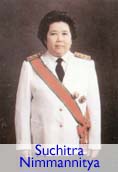Dr. Suchitra Nimmannitya received an M.D. Degree in 1954 from the Faculty of Medicine Siriraj Hospital, Mahidol University, Thailand. She obtained an M.P.H. Degree (Epidemiology and Control of Infectious Diseases) in 1969 from Yale University School of Medicine, U.S.A. She was certified Diplomate, Thai Board of Pediatrics in 1971. She obtained a certificate from UNICEF/WHO Course for Senior Teacher in Child Health on Teaching of Child Health and Delivery of Health Care at Institute of Child Health, University of London, UK in 1976.
Dr. Nimmannitya joined the staff members of the Children’s Hospital in Bangkok in 1957. She was later appointed Chief Division of Infectious Diseases and residency training programme in 1971 and director in 1989. She retired in 1991. Dr. Nimmannitya has been actively involved in Pediatric Society. She was elected President of Pediatric Society of Thailand in 1990-1992 and Vice Chairman, the Royal College of Pediatricians of Thailand in 1995-1997. She has been a lecturer at Faculty of Tropical Medicine, Mahidol University since 1972.
Dr. Nimmannitya’s works on dengue hemorrhagic fever (DHF) started in 1958 when the outbreak first occurred in Bangkok. As a young pediatrician assigned to infectious disease ward, she was responsible in taking care of patients with this new disease. While working hard trying to save lives of patients who were critically ill with this new killing disease of children, Dr. Nimmannitya deliberately studied the clinical features and important laboratory changes that were related to disease severity and were essential for clinical diagnosis and management of this disease. She has described the clinical course and classified disease severity into 4 grades and set up clinical criteria for early and correct diagnosis of DHF. Dr. Nimmannitya has also developed guidelines for management. Both clinical diagnostic criteria and regimen of management of DHF which she has developed and used at the Children’s Hospital have been adopted as recommendations by the World Health Organization (WHO) since 1974 and are now widely used in areas where DHF is present.
Dr. Nimmannitya became associated with the World Health Organization (WHO) when she took assignment to go to Indonesia as WHO short term consultant of DHF in 1972. Since then she has traveled as a consultant to almost all countries in Southeast Asia and to Columbia and Brazil in South America when there was an outbreak of DHF in these countries. She became a member of the World Health Organization Technical Advisory Committee on DHF in 1974 and has ever since become actively involved in WHO Programme on DHF. Her early work on DHF has resulted in better care of DHF patients. With improvement in clinical diagnosis and management, the case fatality rate of DHF has remarkably reduced, from about 12 percent 25 years ago to around 0.5 percent now.
Dr. Nimmannitya has worked in collaboration with the Armed Forces Research Institute of Medical Sciences (Formerly SEATO Laboratory) in research concerning various aspects of DHF. These long term collaborative studies between the Children’s Hospital and AFRIMS since 1962 have elucidated a body of knowledge on the natural history and pathogenesis of DHF. She has 60 published papers (20 as principal author) 50 of which on DHF.
Dr. Nimmannitya is still actively involved in the field of DHF by teaching at various institutes and supervise training of pediatricians and physicians both locally and internationally. She is currently working as a consultant pediatrician, Division of Inflectious Diseases, Children’s Hospital and a WHO Surveillance Consultant on Polio Eradication Programme at the Department of Communicable Diseases Control and Division of Epidemiology, Ministry of Public Health.
 |
Dr. Suchitra Nimmannitya M.D.,M.P.H.Thailand
|

